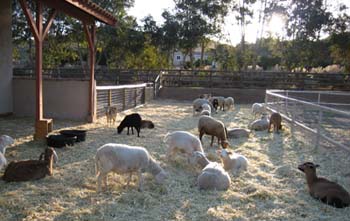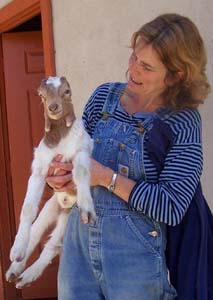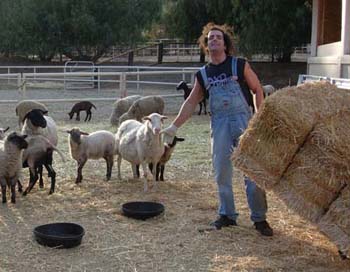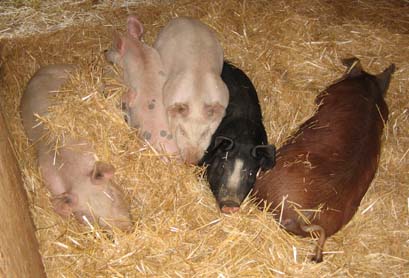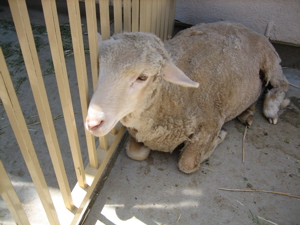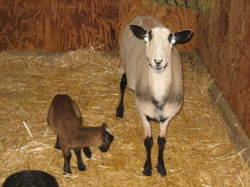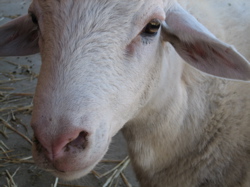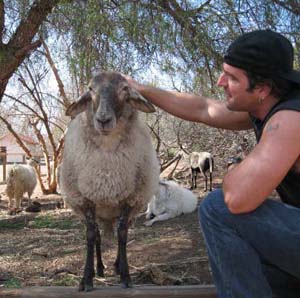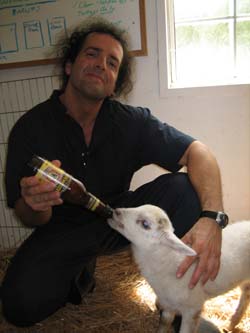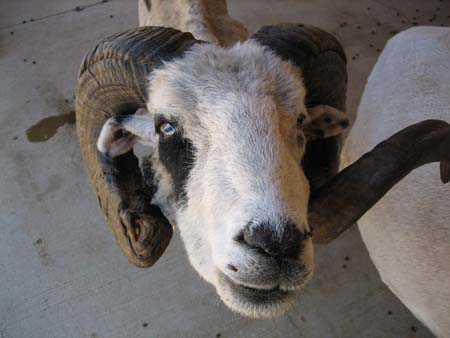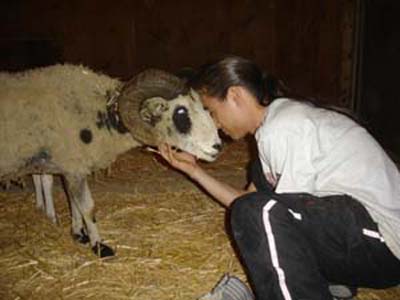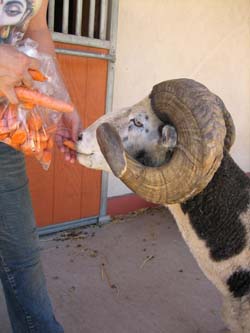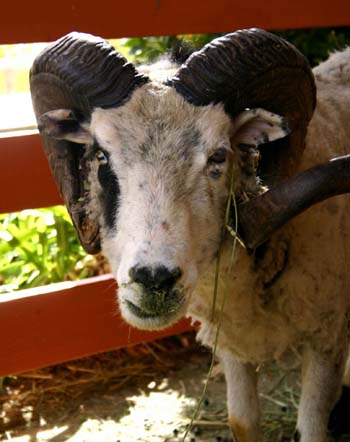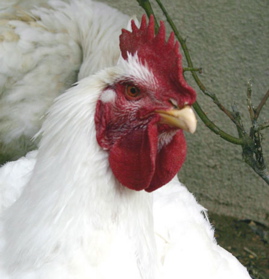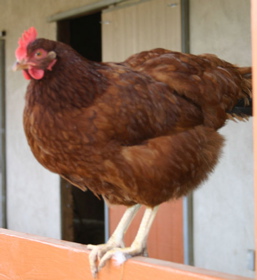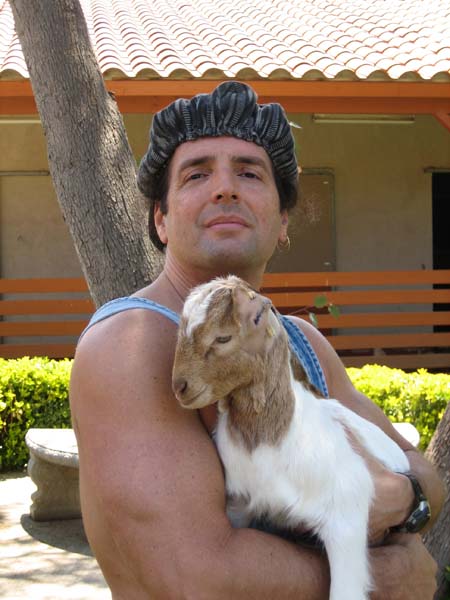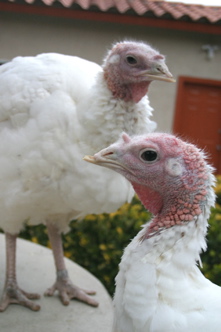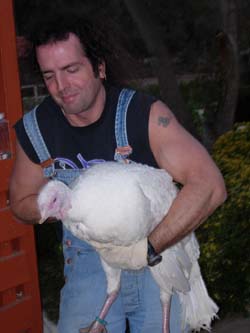 |
Welcome
to the Veggie Zone
Animal Acres Page!
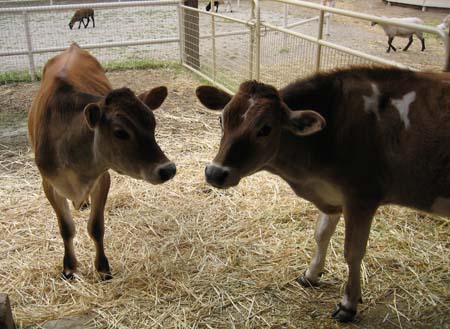
Kirby and Roscoe
Elsewhere on this site, we talk about the "millions and billions" of animals who suffer each year as a direct result of the animal foods, clothing, consumer goods, entertainment and vivisection industries. With these stratospheric numbers, it's difficult to remember that with every senseless death, there is a living being, with his or her own personality, preferences and desire to live, care for their young, and be in the sunshine.
In this part of the site, you will get to know more about "farm" animals, many on a first-name basis. Once you get to experience these beautiful and complex animals on a personal level, it's impossible to regard them as mere commodities, like most people have been conditioned to do.
Any reasonable person who has spent any time at all around farm animals like cows, pigs, chickens, sheep, goats or turkeys knows that they are all sentient beings, in full possession of virtually every emotional, survival and maternal impulse that any other domesticated animal like a dog or a cat possesses. They all feel pain and fear, can be playful or irritable, have their own preferences and personalities and, of course, love to eat!
So let's get to know some of our special friends at Animal Acres.
Here's what we'll be covering in this Animals Acres page (Click on the Go link to skip ahead to that particular section.):
1.
About Animal Acres Go
2. Meet the pigs Go
3. Meet the cows Go
4. Meet the sheep Go
5. Remembering Ramboy Go
6. Meet the chickens Go
7. Meet the goats Go
8. Remembering Colin Go
9.
Meet the turkeys Go
10. Meet the emus Go
11.
More Animal Acres Info Go
| Animal Acres is a farm animal sanctuary and compassionate living center that provides rescue and refuge for farm animals and educates the public about the atrocities that billions of these animals deal with every year around the world. Located just 45 minutes outside of LA in Canyon Country, there are currently over 100 different animals who live at Animal Acres, including pigs, cows, chickens, turkeys, goats, and sheep. We even have one duck and two emus. And believe me when I tell you, they are ALL very well taken care of! |
26 acres of paradise! |
Lorri with Colin |
Animal Acres was founded by Lorri Bauston, who has been a pioneer in the farm animal movement for over 20 years now. She co-founded Farm Sanctuary back in '86 and has brought a tremendous amount of attention to the plight of factory farm animals through tons of media exposure. She has also personally been involved with saving the lives of literally thousands of animals. Lorri is the real deal. Animal Acres started up in Spring 05 and is still run almost exclusively by volunteers. And because it's a non-profit organization, over 90% of the funding comes from private donations. |
|
I
personally try to spend at least one day a week there when I'm
home in LA, cleaning out barns, helping to care for the animals,
showing folks around the place, etc. Spending this kind of one-on-one
time with all the critters there gives you an even deeper perspective
on veganism and an even stronger resolve for the cause. This is
why I wanted to have this special Animal Acres page. |
Me and the gang |
So,
this Animal Acres page is dedicated to all of our animal
pals who live there...and the many more billions out there who we all
wish lived there, too.
(Be sure to check out more info on Animal
Acres at the bottom of the page.)
_______________________________________
Now, let's meet the animals:
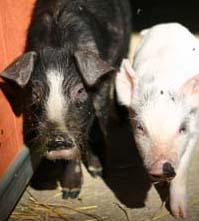 |
 |
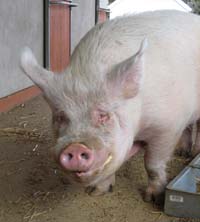 |
Who's who?
Male:
boar
Female: sow
Baby: piglet or shoat
General Info:
Pig Video
Click on the link below to see a video clip of some of our pigs rooting around in the dirt:
_______________________________________
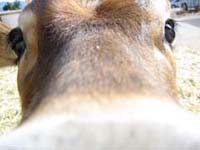 |
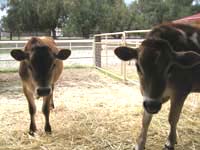 |
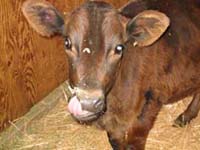 |
Who's who?
Male:
bull (in tact) – steer (castrated)
Female: cow (if she’s over 30 months or has given
birth) –
heifer (if she’s under 30 months and/or has not given birth.)
Baby: calf
General Info:

Bruno is our latest addition in the cow pasture.
Steer Video
Click on the link below to see a video clip of Roscoe and Kirby:
_______________________________________
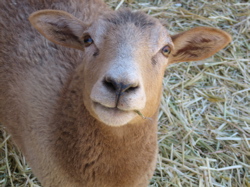 |
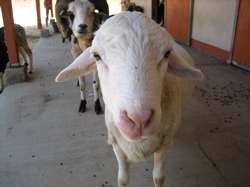 |
Who's who?
Male:
Ram (in tact) – wether (castrated) It’s usually pronounced
like “weather.”
Female: Ewe (pronounced like “you.”)
Baby: Lamb
General Info:
|
Proud mom with lamb |
Oliver, my buddy! |
|
Here's
my little partner Aengus. He was actually born at the Acres
Bottle-feeding
little Aurora, a baby lamb who was |
|
Sheep Video
Click on the link below to see a video clip of some of our sheep. Check out little Aengus trying to get into my bag...just like a puppy:
| "Ramboy" ? - 7/18/06
By the time he got to us almost a year ago, everyone knew he had had a rough-ass life, to say the least. He had been rescued from a local slaughterhouse with over 50 other sheep and goats, having survived some of the most atrocious living conditions imaginable. How long he was there or what all happened to him before then, we'll never know. We never even knew how old he was. But, once he came to the Acres and got some solid medical treatment, he settled into the good life really quick. Ramboy had a profound sweetness about him. I would generally greet him by kneeling down, easing my shoulder against his jaw and scratching him on his chest or the side of his head. He was always very gentle and affectionate...unless he thought you were withholding food from him! Then he could get a little hostile. Some of us volunteers took a hit or two from "Big Ram" on occasion, but we were too surprised by the power he still had for an old-timer to get pissed at him. But this was a very rare thing, and to all of the guests who met him, he was always charming, lovable and affectionate.
My
friend Matt with Ramboy |
|
|
Ramboy loved his carrots! |
Unfortunately, Ramboy's old age and ailing body began to catch up with his warrior spirit. He had been through a hell of a lot in his life and, eventually, it was time for our main man to transcend this plane. We're happy to report that there was little suffering involved in Ramboy's last days. His decline was quick and easy for him, but a devastating surprise for many of us who didn't know the full extent of his age-related health problems. And let me tell you first-hand, his passing was no less painful to us than losing any other companion animal like a dog or cat. No less painful... |
|
Yes, we will all miss Ramboy terribly. But at least we can know that the last 10 or so months of his life when he lived at Animal Acres were joyous and blissful. And we can celebrate the fact that he touched hundreds of people's lives in the process.
Rest
in peace, Ramboy.
Ramboy Video Click on the link below to see a quick video clip of Ramboy having a bite to eat and checking me out with the video camera. |
|
_______________________________________
|
One of our big boy roosters... |
Sybilla, a visitor's favorite |
Who's who?
Male:
rooster
Female: hen
Baby: chicks
“Layers:”
Chickens raised for eggs.
These are the smaller ones that are often caged between five and eight
to a group.
“Broilers:” Chickens raised for meat.
These are the large ones – both hens and roosters –
that we often refer to around the Acres as “Baby Hueys.”
General Info:
By the way:
1.
A “Cornish game hen” is really a young chicken, usually
5 to 6 weeks of age, that weighs no more than 2 pounds.
2. Roosting means to rest or sleep.
3. There are more than 9 billion chickens raised on factory farms each
year in the U.S.
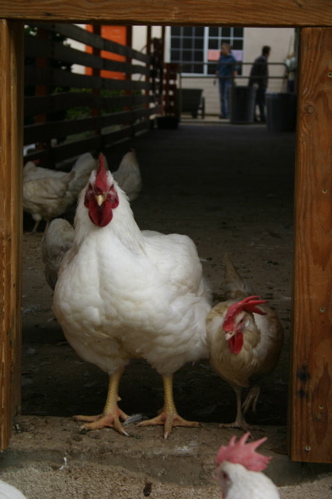
Here
is a rescued "broiler" and a "layer" heading out
to the dirt lot to sunbathe.
Notice the extreme difference in size due to the genetic manipulation
that "broilers" go through in the factory farming world?
Chicken Video
Click on the link below to see a video clip of Sybilla, one of the friendliest of all of the chickens:
_______________________________________
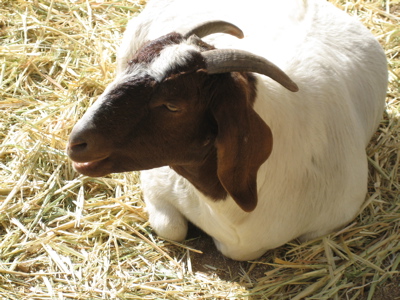
Ellie May
Who's who?
Male:
Billy or buck
Female: Nanny or doe
Baby: Kid
General Info:
By the way:
1.
Goats are exploited for their meat and milk. Their meat is popular primarily
among certain Muslim, Hispanic, Caribbean, and Asian communities.
2. Although I obviously don’t subscribe to either, more people
drink goat’s milk worldwide than cow’s milk.
3. They are also exploited for their skin and fur (mohair, cashmere).
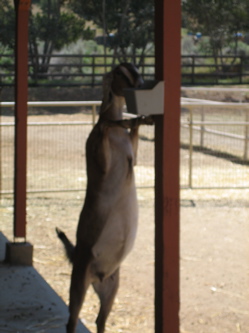 |
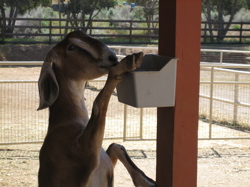 |
Gilly,
with the floppy ears and no horns, is a female goat with a male
name. Here she is, standing up on her own to get to the emu food,
which every goat and sheep at the Acres seems to prefer more than
their own food. |
|
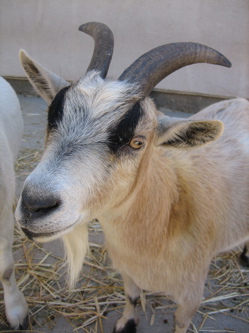 |
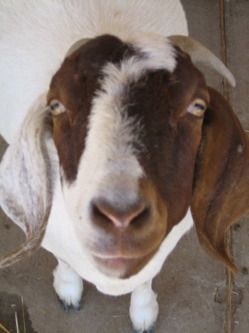 |
|
Hilary
is a sweet little pygmy goat, short and stout with a big tummy.
Everyone always asks if she's pregnant. (No, she's not.) |
As
one of the very first arrivals, Ellie May remains the reigning
queen of Animal Acres! |
| "Colin" 4-9-06? - 5-9-06
After all he had been through in the few short weeks since his birth, we were blown away by how loving and trusting this baby goat was with all of us. Colin was exactly like a puppy or a kitten...just a little bigger. He liked being around people and would cry if you left him alone for too long. Unfortunately, it was an uphill battle for our little buddy since he got there. Not only did he have to endure the trauma of this unspeakable abuse, and then the procedure for fixing his ears (notice that long row of stitches on the side of his head?), but he was also fighting a really bad bacterial condition and was basically under watch around the clock. On Monday afternoon, 5-8-06, he was brought out to meet a group of 60 youngsters from a local elementary school who were at Animal Acres for a field trip. His personal story was a poignant lesson for these kids to see and hear first hand...a statement for the necessity of compassion and the absolute futility of cruelty and violence. These young students were visibly moved. It would be Colin's final gift to us before passing away later that night. |
|
| The reality is, this kind of abuse happens to animals by the millions, in one form or another, every day. And I think that, as a self-preservation mechanism, most of us animal rights advocates learn how to disconnect from the glare of this reality, at least a little bit. But to see it all so up-close-and-personal in the innocent face of such sweetness and beauty...there is no disconnecting. It's like a fist in your face, and it's hard not to jump into a rage about who would abuse a little goat like this. |
 |
| However, to truly honor our little partner, we must try to "disconnect" from any prolonged expressions of rage or anger that we may feel. For this kind of energy will only serve to perpetuate the very toxicity in our world that created the conditions for someone to do such a thing to begin with. Let's be inspired by the anger, if we must, but let's raise its vibration to a level that's more useful to the cause. And let's each be even more committed to the cause in our daily lives than ever before, as we continue to take extra care in expressing peace and compassion to our fellow animals in all of our food, clothing, consumer goods and entertainment choices. This is how we honor a life like Colin's.
We'll
miss you, buddy... |
|
_______________________________________
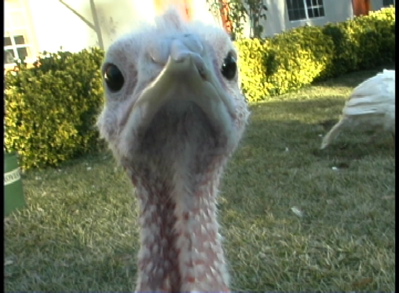
Who's who?
Male:
tom or gobbler
Female: hen
Baby: poult
General Info:
|
A
couple of our little partners, |
Carrying
one of the turkeys to the stable. |
Turkey Video
Click on the link below to see a video clip of a couple of our very curious turkeys, pecking at the camera lens:
_______________________________________
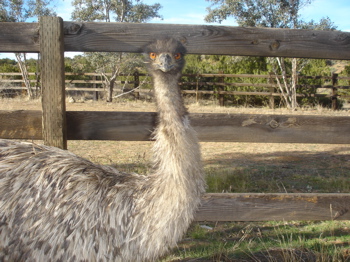
Kata
Who's who?
Male:
Emu
Female: Emu
Baby: chick
General Info:
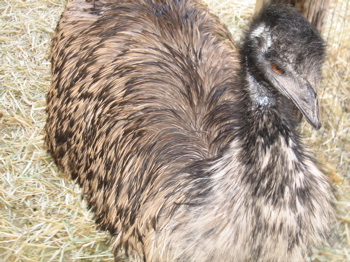
Edgar
By the way:
1.
Originally
there were three species of emu, but now there is only one. The other
two species became extinct because they were hunted for their meat and
feathers.
2. Emu
farming is a relatively new agri-business, gaining popularity among
small farmers where they are exploited for their meat, oil and skins.
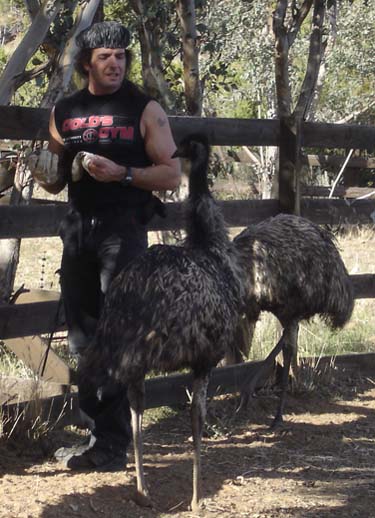
Hangin'
in the back pasture with Edgar and Kata.
Emu Video
Click on the link below to see a video clip of Edgar with one of the Acres' long-time caregivers, Teresa.
_______________________________________

Be sure and read all about this fantastic farm animal sanctuary and compassionate living center at the official Animal Acres web site: http://www.animalacres.org
As mentioned, the place relies heavily on volunteers and, as a non-profit, receives over 90% of its funding from members and private donations. Check the site; there are a number of donation opportunities, and you can even make your contribution online.
Also, if you are ever in the LA area, you've got to come out for a visit (Sundays are tour days) or, better yet, come on down for a few hours as a volunteer and muck a few barns. This is the best way to get to know the animals.
Thanks for dropping by the Animal Acres page. We'll try to keep things updated around here...
Check back soon!
Home - - About Bobby Rock - - Commonly Asked Questions - -
Animal Acres Page - -E-mail Bobby - - Rights vs. Welfare Essay
© 2002-2008 Bobby Rock










